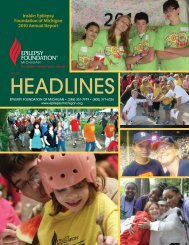Legal Rights of Children with Epilepsy in School & Child Care
Legal Rights of Children with Epilepsy in School & Child Care
Legal Rights of Children with Epilepsy in School & Child Care
You also want an ePaper? Increase the reach of your titles
YUMPU automatically turns print PDFs into web optimized ePapers that Google loves.
<strong>Legal</strong> <strong>Rights</strong> <strong>of</strong> <strong><strong>Child</strong>ren</strong> <strong>with</strong> <strong>Epilepsy</strong> <strong>in</strong> <strong>School</strong> and <strong>Child</strong> <strong>Care</strong><br />
idiopathic, which means it is <strong>of</strong> unknown cause, though <strong>of</strong>ten it is familial, or<br />
caused by a bra<strong>in</strong> <strong>in</strong>jury. <strong>Epilepsy</strong> can also be part <strong>of</strong> a more complex syndrome<br />
<strong>in</strong> which the bra<strong>in</strong> and possibly other organs are affected. If this is the case,<br />
seizures may be only one <strong>of</strong> many issues that will need to be addressed <strong>in</strong> the<br />
education or child care sett<strong>in</strong>g. A third classification scheme is based on how<br />
well seizures are controlled by medic<strong>in</strong>es.<br />
1.5Q:<br />
Are there different types <strong>of</strong> seizures?<br />
A: Yes. There are a number <strong>of</strong> different types <strong>of</strong> seizures, but they fall <strong>in</strong>to two<br />
major groups — partial seizures and generalized seizures.<br />
1.6Q:<br />
What are partial seizures?<br />
A: Partial seizures are seizures <strong>in</strong> which the electrical short-circuit <strong>of</strong> the neurons is<br />
limited to a specific area <strong>of</strong> the bra<strong>in</strong>. Partial seizures are divided <strong>in</strong>to two<br />
categories: simple partial seizures, <strong>in</strong> which the person experienc<strong>in</strong>g the seizure<br />
does not lose consciousness, and complex partial seizures, <strong>in</strong> which the person<br />
hav<strong>in</strong>g the seizure loses consciousness or has impaired consciousness.<br />
Simple partial seizures result from “abnormal neuronal activity <strong>in</strong> specific<br />
limited areas <strong>of</strong> the bra<strong>in</strong> that affect movement, sensation or emotion.”<br />
Manag<strong>in</strong>g Students <strong>with</strong> Seizures at 16. Dur<strong>in</strong>g a simple partial seizure, a person<br />
rema<strong>in</strong>s aware <strong>of</strong> what is go<strong>in</strong>g on, but may be limited <strong>in</strong> how he or she can<br />
react. He or she may not be able to speak, or may experience t<strong>in</strong>gl<strong>in</strong>g or nausea,<br />
visual distortions, or other symptoms that may serve as a warn<strong>in</strong>g <strong>of</strong> a more<br />
severe seizure to come. 4<br />
Complex partial seizures beg<strong>in</strong> <strong>in</strong> one area <strong>of</strong> the bra<strong>in</strong> but usually spread to<br />
other portions <strong>of</strong> the bra<strong>in</strong>, <strong>in</strong>clud<strong>in</strong>g the opposite side, and <strong>in</strong>volve a change <strong>in</strong><br />
consciousness. The person who has the seizure usually will not remember what<br />
happened dur<strong>in</strong>g the seizure. While hav<strong>in</strong>g the seizure, the person may engage<br />
<strong>in</strong> automatic behaviors such as lip smack<strong>in</strong>g, chew<strong>in</strong>g or swallow<strong>in</strong>g, fidget<strong>in</strong>g,<br />
or other repetitious behaviors. In some cases, complex partial seizures may<br />
cause a person to engage <strong>in</strong> more significant behaviors such as undress<strong>in</strong>g,<br />
scream<strong>in</strong>g, runn<strong>in</strong>g and flail<strong>in</strong>g. If a person experienc<strong>in</strong>g such a seizure is<br />
touched or restra<strong>in</strong>ed, he or she may become combative. These behaviors are<br />
much less common but create obvious difficulties for the people who experience<br />
them. Manag<strong>in</strong>g Students <strong>with</strong> Seizures, p. 16.<br />
4 As <strong>with</strong> the visual and other neurological disturbances that may precede a migra<strong>in</strong>e headache for some<br />
people, these pre-seizure events or symptoms are called an “aura.”<br />
6








